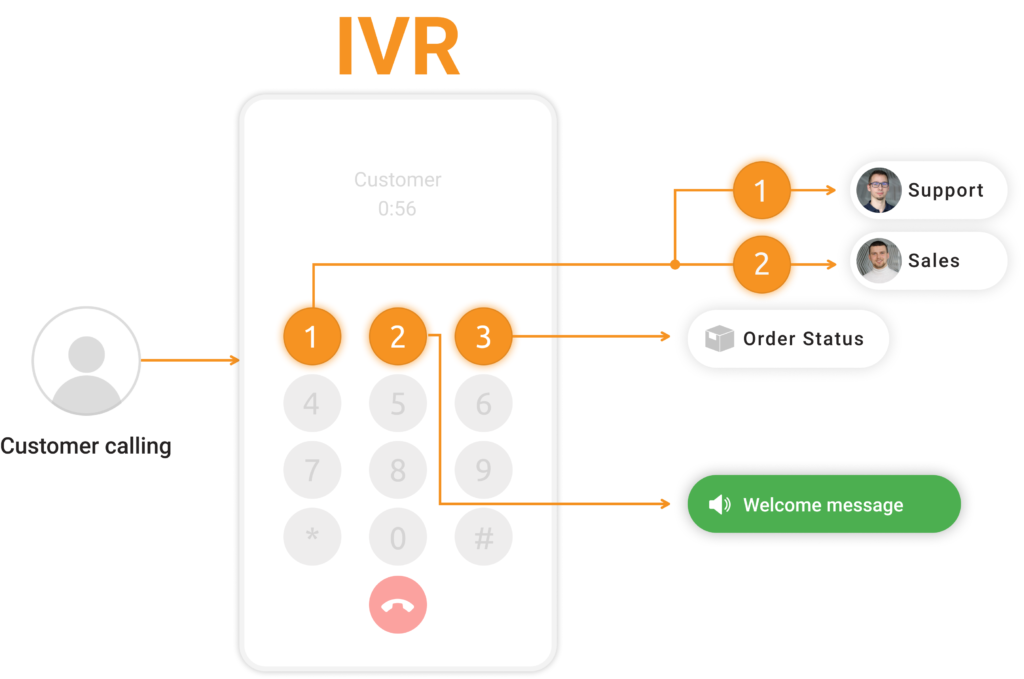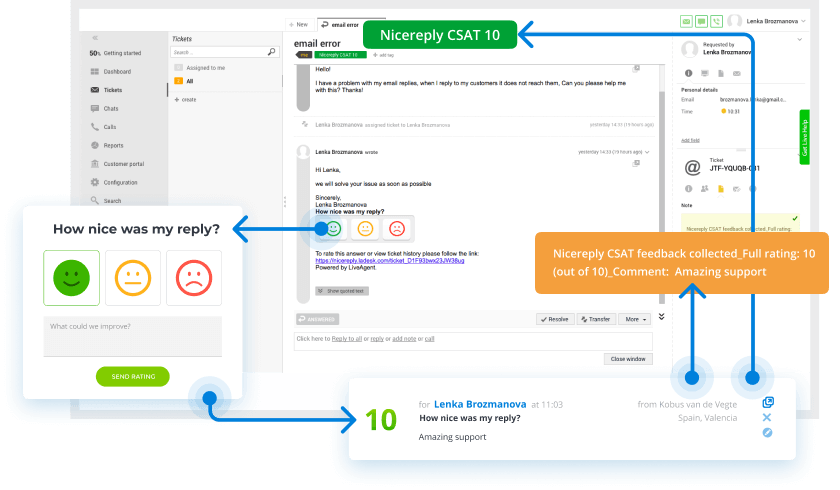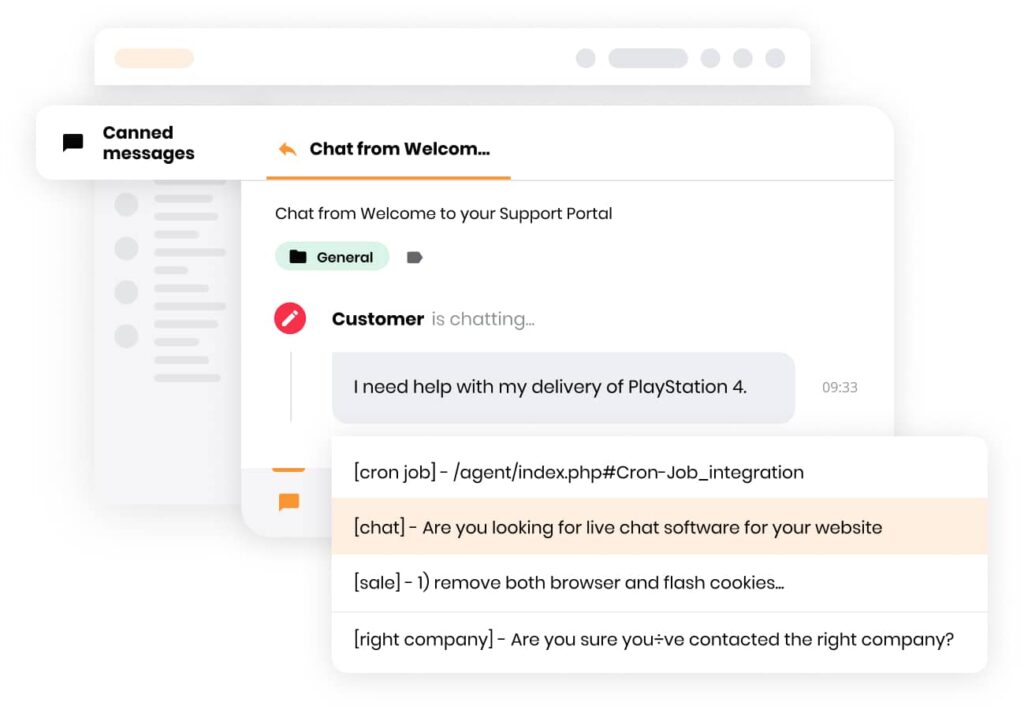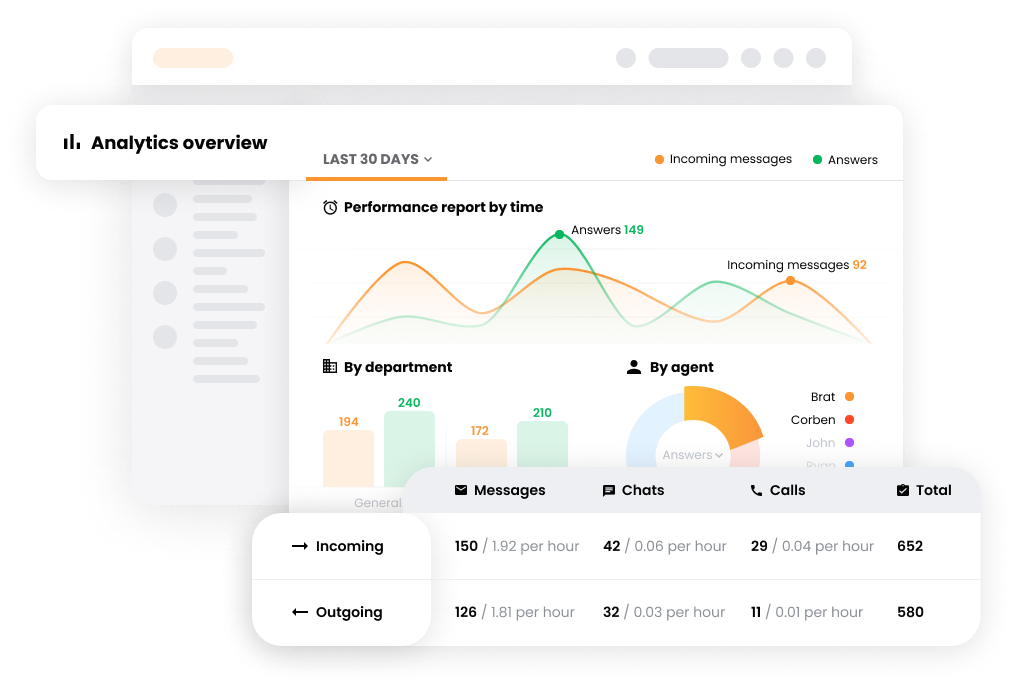In a world where delivery speed and reliability are paramount, exceptional customer service in logistics can be your game-changer. As consumers increasingly prioritize seamless shipping experiences, the stakes for logistics companies have never been higher.
Understanding the dynamics of logistics means recognizing that customer service is not just an ancillary function; it’s integral to success. From clear communication to effective order tracking, the components of strong customer service have lasting impacts on customer retention and brand reputation.
This article will explore how logistics businesses can elevate their customer service, tackle common challenges, and leverage technology—like LiveAgent—to enhance their support systems, ensuring that they stand out in a competitive market.
Table of Contents
- The importance of customer service in logistics
- Key components of effective customer service in logistics
- Challenges in providing customer service within logistics
- Strategies for improving customer service in logistics
- The role of proactive communication
- Personalized support in the logistics sector
- Measuring customer service performance
- The impact of customer service on brand reputation
- Building trust through reliable practices
- Customer retention strategies in logistics
- Differentiating logistics companies through exceptional service
- Conclusion
The importance of customer service in logistics
Customer service in logistics is vital for building trust and ensuring customer satisfaction. This, in turn, drives business growth and fosters long-term relationships. Providing exceptional customer service sets logistics companies apart from competitors, helping them thrive in a crowded market.
A positive experience throughout the shipping and delivery process encourages customer loyalty and increases the likelihood of repeat business. Effective communication and support for customers throughout logistics operations are key to reducing churn and maintaining a competitive advantage.
Consider these benefits:
- Customer Satisfaction: Meeting expectations ensures a positive experience.
- Customer Loyalty: Transparent communication builds trust.
- Reputation Management: Avoid negative reviews by providing excellent service.
- Business Growth: Happy customers promote your services.
Negative experiences can lead to harmful social media reviews, tarnishing a company’s reputation. Therefore, investing in superior customer service, through tools like LiveAgent, enhances overall satisfaction. LiveAgent provides real-time updates and supply chain visibility to meet customer expectations effectively.
Key components of effective customer service in logistics
Effective customer service is the backbone of successful logistics operations. It’s crucial for overcoming challenges and ensuring customer satisfaction. When done right, it helps build a positive brand image and fosters long-term loyalty. A robust logistics plan requires excellent customer service to keep operations smooth and address customers’ needs promptly.
Providing exceptional customer service enables logistics companies to establish lasting partnerships. This drives business growth and enhances their competitive advantage. Strong customer service also contributes to higher retention rates by building trust and resolving issues effectively. This reduces costs associated with complaints and returns. In today’s market, seamless communication and prompt customer inquiry resolution are vital. Customers’ expectations are higher than ever, making these components essential for standing out.
Communication strategies
Enhancing communication throughout the logistics process is vital. It helps improve customer service and keeps customers informed about their shipments. Real-time updates on shipment status, delivery estimates, and potential delays can significantly boost customer satisfaction. Proactive communication about changes or issues ensures customers feel informed and valued.
Implementing technologies like SMS notifications, email alerts, and automated tracking updates provide customers with order visibility. Integrating customer service and logistics systems in this way automates processes, reduces errors, and improves communication efficiency. Here’s a quick table summarizing the benefits:
| Component | Benefit |
|---|---|
| Real-time updates | Enhanced customer satisfaction |
| Proactive communication | Customers feel valued and informed |
| Integration | Reduced errors and improved communication efficiency |
Leveraging technology for support
Technology plays a pivotal role in logistics customer service. Integrating logistics management software enhances information visibility. This enables real-time tracking and predictive analytics for accurate delivery estimates. Chat-based platforms, including chatbots, provide immediate responses to queries over various channels. Automating customer support tasks like shipment updates saves time and boosts operational efficiency.

Additionally, self-service tools like Interactive Voice Response (IVR) empower customers. They can access relevant services independently, enhancing their logistics provider experience. Leveraging technology reduces errors and improves operational efficiency by better integrating logistics and customer service systems.
Optimizing order tracking
Order tracking is another critical component of logistics customer service. Investing in advanced tracking systems allows logistics companies to offer accurate, up-to-date information. This lets customers track their shipments online or through mobile apps.
Order tracking not only satisfies customer demands but also reduces anxiety about deliveries. This enhances the overall customer experience. Automated tracking significantly reduces operational costs related to problem resolutions and tracking inquiries. Streamlined communication solutions and timely updates on shipment status accommodate last-minute requests effortlessly.
Effective order tracking systems improve brand reputation. Clients satisfied with their delivery experiences are more likely to leave positive reviews. Ultimately, optimizing order tracking contributes to a superior customer experience and strengthens the company’s market position.
Optimize Your Logistics Support
Streamline your customer service operations and ensure on-time delivery with the right tools. See the difference today!
Challenges in providing customer service within logistics
Customer service is a critical aspect of the logistics industry. However, various obstacles can complicate its effective implementation. Let’s explore these challenges and strategies to improve customer service in logistics.
Supply chain complexity
The modern supply chain is a complex web involving manufacturers, carriers, distributors, and retailers. This complexity increases the likelihood of delivery delays and miscommunications. Each handoff point is a potential bottleneck, threatening to disrupt the flow of goods.
For instance, an unexpected weather event or political change could affect the entire supply chain, causing significant delays. To combat these challenges, maintaining effective communication among all parties is essential. Transparent communication can improve supply chain visibility, helping to ensure timely deliveries and positively impact customer satisfaction.

Technological obstacles
Technology offers great potential for improving logistics but presents its challenges too. Adopting and implementing new technologies, such as cloud computing and artificial intelligence, can be costly and complex. Training employees to use these technologies effectively is essential, but it requires time and resources.
Ineffective management of technological transitions can disrupt everyday operations, leading to delayed shipments and customer dissatisfaction. Yet, overcoming these obstacles is crucial. By integrating cutting-edge customer service tools, like LiveAgent, businesses can manage customer inquiries more efficiently. This software allows for real-time updates and effective communication, reducing issues that arise from fragmented data.
Improving customer service within logistics requires addressing supply chain complexity and technological obstacles. Making strategic use of customer service software like LiveAgent can be a game-changer in delivering exceptional service and meeting customer expectations consistently. Investing in effective communication tools is key to building long-term relationships and gaining a competitive advantage in the logistics industry.
Strategies for improving customer service in logistics
A well-oiled operation leads to customer loyalty and positive experiences. Companies looking to improve their service must focus on communication, timely delivery, and adapting to customer expectations. Here’s how strategies can be implemented to achieve excellent customer service in logistics.
Enhancing customer interactions
Enhancing client interaction is crucial for creating positive reviews and long-term relationships. Providing real-time updates on shipment status through advanced order tracking systems is essential. This transparency gives customers peace of mind and sets their expectations correctly. Furthermore, proactive communication about potential delays or changes in orders can turn a possibly negative experience into a smooth one.
Personalization plays a significant role here. Learning about customer preferences and needs allows companies to tailor their service and meet specific demands. This is part of delivering exceptional service. Transparent communication builds trust. Mistakes should be addressed promptly and honestly, maintaining the company’s reputation.

In addition, offering 24/7 customer support, including multilingual services, is necessary. With clients across different time zones, support should be seamless and accessible. Investing in infrastructures, like LiveAgent customer service software, ensures consistent, effective communication, proving indispensable for businesses.
Implementing feedback mechanisms
Feedback from customers is a goldmine for logistics firms. It provides insights into what works and what doesn’t, enabling dynamic adjustments. Continuously collecting feedback through surveys, reviews, and direct communication identifies areas needing improvement. This builds a feedback loop, essential for meeting customer needs and driving business growth.
A structured customer service desk for handling feedback is beneficial. It should facilitate swift problem resolutions and bolster customer satisfaction and loyalty with its efficiency. For instance, analyzing both positive and negative feedback can help create strategies that enhance customer service and the delivery process.
Establishing continuous feedback mechanisms is crucial for garnering insights that enable systemic improvements. This proactive approach ensures logistics businesses remain agile, adapting swiftly to any emerging issues. By investing in feedback systems and communication tools, such as LiveAgent, companies can gain a competitive advantage in the market.

Overall, the success in logistics customer services lies in adopting a customer-centric approach. Whether through enhanced interactions or effective feedback mechanisms, logistics firms can achieve a high level of customer satisfaction and loyalty.
The role of proactive communication
Proactive communication plays a critical role in the logistics industry by managing customer expectations. Keeping customers informed about delivery schedules and potential issues, such as delays or route problems, helps reduce frustration and anxiety. By providing timely updates, logistics companies can ensure a positive experience for their customers.
Effective communication between customer service and logistics teams is essential. Quick responses to customer inquiries and problems enhance overall satisfaction. Transparent communication fosters trust, which is vital for maintaining strong relationships with customers in logistics.
Proactive problem-solving through clear communication channels can identify potential challenges before they escalate. This approach helps logistics companies mitigate issues efficiently.
Key benefits of proactive communication:
- Reduces customer frustration
- Enhances trust and confidence
- Promotes quick problem resolution

By focusing on these aspects, logistics companies can improve their level of customer service. For those looking for an effective solution, LiveAgent provides software that streamlines communication and ensures exceptional service. Its features include real-time updates and transparent communication, making it an excellent choice for the entire supply chain.
Personalized support in the logistics sector
Personalized assistance in logistics enhances the customer experience throughout the shipping process. Logistics providers are crucial in managing various stakeholders, such as carriers and warehouses, to ensure timely and accurate delivery. This tailored service meets customer needs effectively.
Offering multilingual support through channels like phone, email, and live chat is essential. This approach allows logistics companies to serve a diverse customer base effectively. Moreover, implementing order tracking technology with delivery route alerts provides personalized updates, boosting customer satisfaction.
Actively seeking customer feedback is vital. It helps logistics providers refine their services and develop tailored solutions. This not only improves the immediate service but also fosters long-term relationships with clients.
Key Strategies for Personalized Support:
- Manage stakeholders: Coordinate with carriers and warehouses.
- Multilingual support: Use multiple communication channels.
- Order tracking: Implement real-time updates and alerts.
- Feedback collection: Regularly gather and respond to customer opinions.
By adopting these strategies, logistics companies can offer personalized support, enhancing customer satisfaction and fostering loyalty. This approach is essential for maintaining competitive advantage in today’s logistics industry.
Measuring customer service performance
On-time delivery is a key factor. It impacts customer satisfaction and retention directly. To measure performance, businesses must track order cycle time, which includes order transmittal, processing, stock acquisition, and delivery. Monitoring these components efficiently is essential.
To enhance performance, companies should focus on effective customer service. This can enhance their brand image, leading to positive reviews and increased loyalty. Collecting regular customer feedback is vital. It helps identify strengths and areas for improvement in service delivery.
Supply chain visibility tools play a vital role. They offer transparency and provide reassurance about order status. For those seeking a competitive edge, LiveAgent offers a robust solution by integrating real-time updates and efficient communication channels.

A combination of efficient delivery, effective communication, and customer feedback ensures superior service in logistics. Here’s a quick checklist for improving performance:
- Monitor order cycle components
- Collect customer feedback
- Implement supply chain visibility tools
- Use customer service software like LiveAgent
These steps can help create positive experiences and foster long-term relationships with customers.
The impact of customer service on brand reputation
Customer service plays a critical role in shaping a brand’s image. It helps foster loyal customers who are inclined to share positive reviews and recommendations. A strong emphasis on customer service can boost a brand’s visibility and credibility, setting a company apart in the competitive logistics industry.
Investing in positive and attentive customer care representatives leaves a lasting impression of care. This bolsters brand reputation and builds customer trust. Effective communication can turn logistics challenges into positive experiences, enhancing customer satisfaction and loyalty.
However, consistently poor customer service can have the opposite effect. It often leads to negative reviews on social media, which can severely damage a brand’s reputation. This not only affects customer trust but also impacts long-term relationships with clients.
To summarize:
- Positive customer service increases loyalty and positive reviews.
- Attentive service enhances brand reputation and credibility.
- Poor service risks negative reviews, harming the brand.
By focusing on superior customer service, companies can maintain a strong brand reputation, gaining a competitive advantage in the logistics sector.
Building trust through reliable practices
Building trust in logistics hinges on consistent communication, accurate information, and reliable service delivered by customer service teams. Establishing strong relationships with customers is vital. This is achieved through responsiveness, proactivity, and transparency. Positive experiences with a logistics provider enhance customer retention, leading to increased loyalty and higher lifetime value for the company.
Key practices to build trust:
- Transparent communication: Always keep the customer informed with real-time updates.
- Proactive problem-solving: Address issues like delayed shipments or damaged packages promptly. Turn challenges into opportunities to strengthen relationships.
- Responsive service: Quick and effective responses to customer inquiries improve satisfaction.
Investing in exceptional customer service enhances the overall customer experience. It significantly contributes to a logistics provider’s reputation as trustworthy and reliable. LiveAgent, an efficient customer service software, can provide the tools necessary for delivering superior customer service. Its features allow logistics companies to improve their responsiveness and ensure transparent communication, paving the way for trust and long-term customer loyalty.
Customer retention strategies in logistics
Enhancing customer retention in logistics hinges on exceptional customer service. Building trust with clients leads to greater loyalty, as customers prefer returning to providers that support them throughout the process. Retaining existing customers costs five times less than acquiring new ones, underlining the importance of superior customer service.
Key strategies for customer retention:
- Prompt issue resolution: Address delivery delays or damaged goods quickly to minimize frustration and maintain satisfaction.
- Positive word-of-mouth: Satisfied customers share their experiences, boosting reputation.
- Investment in effective tools: Utilize customer service software like LiveAgent for efficient communication and tracking.
| Strategy | Impact |
|---|---|
| Prompt Resolutions | Minimizes frustration, maintains trust |
| Positive Experiences | Enhances reputation with word-of-mouth |
| Effective Tools | Streamlines communication, improves service efficiently |
Focusing on these strategies not only increases customer satisfaction but also reduces costs and bolsters brand reputation. Prioritizing customer service in logistics management is key to fostering loyalty and encouraging business growth. This approach ensures long-term relationships and a competitive edge in the logistics industry.
Differentiating logistics companies through exceptional service
Exceptional customer service is a game-changer in the logistics industry. Providing excellent service leads to customer loyalty and positive reviews, contributing to organic word-of-mouth advertising. This boosts brand image and helps companies stand out in a competitive market. Logistics companies offering a smooth shipping experience attract customers who value such efficiency.
Investing in superior customer service has a profound impact on business growth. For example, a mere 5% increase in customer retention can lead to a profit increase of 25% to 95%. This clearly indicates the importance of customer service in logistics.
Effective communication and proactive problem-solving play vital roles in enhancing customer satisfaction. By integrating customer service into logistics management, companies can improve responsiveness and foster long-term relationships with customers. Below is a quick list showing how exceptional customer service can differentiate logistics companies:
- Enhances customer satisfaction
- Boosts customer loyalty
- Drives business growth
- Improves communication and supply chain visibility
- Encourages positive feedback and reviews
For those seeking to elevate their logistics services, LiveAgent customer service software offers real-time updates and seamless support, ensuring a superior level of customer service that meets and exceeds expectations.
Optimize Your Logistics Support
Streamline your customer service operations and ensure on-time delivery with the right tools. See the difference today!
Conclusion
Customer service in logistics plays a vital role in ensuring customer satisfaction and building a strong brand reputation. Effective customer service not only addresses common challenges like delivery delays and communication breakdowns but also contributes significantly to business growth and customer loyalty. By implementing robust customer service strategies, logistics companies can achieve long-term savings, improve delivery times, and maintain a positive relationship with customers.
For businesses looking to enhance their customer service excellence in logistics, using reliable software solutions like LiveAgent can be transformative. LiveAgent helps improve communication, customer feedback management, and provides real-time updates, thus giving companies a competitive advantage in the logistics industry. Don’t wait for tomorrow, try our 30-day free trial today!
Share this article
Provide excellent customer service.
Discover unparalleled customer support with LiveAgent's all-in-one software. Benefit from 24/7 service, a free trial without a credit card, and seamless integration across 130+ ticketing features. Enhance your business with fast setup, AI assistance, live chat, and more. Choose LiveAgent for exceptional service and satisfied customers.
LiveAgent monthly updates: February edition
Explore LiveAgent's February updates: AI Chatbot preview, refined ticket design, security enhancements & fixes for seamless support!"

 Български
Български  Čeština
Čeština  Dansk
Dansk  Deutsch
Deutsch  Eesti
Eesti  Español
Español  Français
Français  Ελληνικα
Ελληνικα  Hrvatski
Hrvatski  Italiano
Italiano  Latviešu
Latviešu  Lietuviškai
Lietuviškai  Magyar
Magyar  Nederlands
Nederlands  Norsk bokmål
Norsk bokmål  Polski
Polski  Română
Română  Русский
Русский  Slovenčina
Slovenčina  Slovenščina
Slovenščina  简体中文
简体中文  Tagalog
Tagalog  Tiếng Việt
Tiếng Việt  العربية
العربية  Português
Português 







